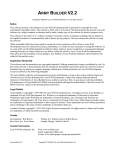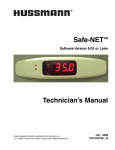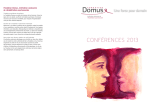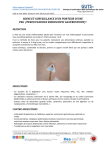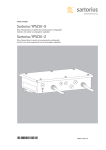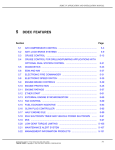Download S810-CFW1 User`s Manual
Transcript
CAN Flash Microcomputer Programmer S810-CFW1 Operation Manual Sunny Giken Inc. Sunny Giken Inc. This operation manual is described in accordance with the S810-CFW1 Ver1.10. CAN Flash Microcomputer Programmer S810-CFW1 Contents of this manual may be revised without notice. We, Sunny Giken Inc. shall not be responsible for any damages and/or losses caused by using this product and/or the software attached to this product claimed by users and/or any intermediaries. Specifications of this product and/or the software attached to this product may be modified without notice due to product improvements. Names of systems, products, and/or services used in this manual are either registered trademarks or trademarks of each manufacturer. In addition, captions of the TM and (R) are not mentioned in this manual. S810-CFW1, CAN Flash Microcomputer Programmer Operation Manual 1 Sunny Giken Inc. 1 Outline .....................................................................................................................................................................3 1.1 Precautions ......................................................................................................................................................3 1.2 System Configuration .....................................................................................................................................4 2 Specifications...........................................................................................................................................................5 2.1 General Specifications ....................................................................................................................................5 2.2 Power Supply Specifications ..........................................................................................................................5 2.3 Function Specifications...................................................................................................................................6 2.4 Programmable Devices...................................................................................................................................6 3 Installation ..............................................................................................................................................................7 3.1 Installing Software..........................................................................................................................................7 3.2 Uninstalling Software.....................................................................................................................................7 3.3 Installing Acrobat Reader...............................................................................................................................7 3.4 Installing USB Driver.....................................................................................................................................7 3.5 Disconnecting USB Cable from a PC..........................................................................................................10 4 Panel Description ................................................................................................................................................. 11 4.1 S810-CFW1 Unit........................................................................................................................................... 11 5 Instructions for Connection and Standalone Operation ..................................................................................13 5.1 PC Remote CAN Programming Mode ........................................................................................................14 5.2 Standalone CAN Programming Mode ........................................................................................................17 6 Specifications of CAN Programming Cable.......................................................................................................20 6.1 Connector .......................................................................................................................................................20 6.2 Pin Assignment..............................................................................................................................................20 7 Connection Circuit Example ...............................................................................................................................21 7.1 Onboard Programming (CAN Input Output Mode)..................................................................................21 7.2 Network Programming (CPU Rewriting Mode) ........................................................................................27 7.3 Connecting a Probe for a Watch-dog Timer................................................................................................29 8 Operation by PC Control .....................................................................................................................................30 8.1 Main Programming Screens ........................................................................................................................30 8.2 Menu Bar .......................................................................................................................................................38 8.2.1 Project Menu.................................................................................................................................................38 8.2.2 Edit Menu......................................................................................................................................................39 8.2.3 Help Menu.....................................................................................................................................................42 8.3 Error Messages..............................................................................................................................................43 9 List of LED Status................................................................................................................................................45 10 Updating Firmware ...........................................................................................................................................46 S810-CFW1, CAN Flash Microcomputer Programmer Operation Manual 2 Sunny Giken Inc. 1 Outline 1.1 Precautions Thank you for purchasing our product S810-CFW1, the CAN Flash Microcomputer Programmer. Please read this operation manual carefully to understand the function of this product for effective and stable operation. Please beware that Sunny Giken Inc. shall have no liability for any damage and/or troubles caused by misuse or careless handling. 1) General Caution Please follow the precautions mentioned below to avoid hazards such as fire, burns, electric shock, and/or injures. ● Make sure that the power switch of this product is turned OFF and your hands are clean and dry when an AC adapter is plugged in. ● Use this product under proper environment. ● Never place this product up-side-down or lateral side facing to table. ● Handle this product with care to avoid fall and/or physical shock. ● Never take this product apart and/or modify by yourself. 2) Operating Environmental Condition ● Unusable environment Dusty place Place in the presence of corrosive gasses Place exposed to direct sunlight Place surrounded by noise source equipment Place with severe mechanical shock and/or constant mechanical vibration ● Ambient temperature 0°C to +40°C Humidity : below 80% (non condensing) ● Prevention of electrostatic is recommended in operating this product and devices. 3) Storage ● Place this product into the packing box in which the product was delivered when you purchased. Store it at shaded place with the ambient temperature of -10°C to +40°C and below 80% of humidity (non condensing) for long term storage. 4) Transportation ● In case the product is needed to be relocated, use the packing box in which the product was delivered when you purchased. 5) Cleaning ● Wipe the product with soft and clean fabric. Do not use any sort of organic solvent such as benzine that may cause deterioration of this product. S810-CFW1, CAN Flash Microcomputer Programmer Operation Manual 3 Sunny Giken Inc. 1.2 System Configuration The entire system configuration of the CAN Flash Microcomputer Programmer (hereinafter called “CFW1”) is illustrated below. CD-ROM Control Program Operation Manual Others PC Renesas CAN microcomputer USB connecting cable DC cable CAN programming cable User prepared target board * AC adapter is not included as part of the product. * See “5. Setting Up” for details of connection. S810-CFW1, CAN Flash Microcomputer Programmer Operation Manual 4 Sunny Giken Inc. 2 Specifications 2.1 General Specifications Main unit of the CFW1 Ambient temperature: 0°C to 40°C Operating Humidity: below 80% (non condensing) environment Storage Ambient temperature: -10°C to +40°C environment External Approximately 85 (W) x 60.5 (D) x 18 (H) mm (Projection not included) dimensions Weight Approximately 75g (only the main unit) 2.2 Power Supply Specifications Using DC Cable Power supply DC +12V Power consumption 200mA maximum, 50mA average The polarity of this DC cable is illustrated below. 500mm Wire color RED:DC+12V BLACK:GND Using CAN Cable Power supply DC +5V ±5% Power consumption 300mA maximum, 100mA average Using USB Cable Power supply DC +5V ±5% Power consumption 500mA maximum, 100mA average * DC +5V±5%, maximum of 500mA of power supply is needed to start CFW1. When using USB cable, use PC or USB hub that bears minimum of 4.75V, 500mA of power supply. S810-CFW1, CAN Flash Microcomputer Programmer Operation Manual 5 Sunny Giken Inc. 2.3 Function Specifications Programmable MCU Operation Mode Program Mode Renesas CAN Microcomputers See “cfw1deve.pdf” in the attached CD-ROM. CAN programming mode PC remote CAN programming Standalone CAN programming PC control Software All the operation can be achieved from your PC with easy-to-operate GUI(Graphic User Interface). Applicable to Windows98/2000/Me/XP. Interface USB (Full Speed: 12Mbps) 2.4 Programmable Devices Programmable devices are the Renesas CAN Microcomputers. Some of the devices are, however, still under evaluation or not yet programmable. Refer to the attached file “Programmable Device List” in the attached CD-ROM. For the latest information, contact Sunny Giken Inc.. S810-CFW1, CAN Flash Microcomputer Programmer Operation Manual 6 Sunny Giken Inc. 3 Installation 3.1 Installing Software Start “Setup.exe” in the S810-CFW1 folder in the attached CD-ROM. Follow the messages of the installer. 3.2 Uninstalling Software Execute “Add/Remove Programs” in the control panel and select “S810-CFW1” in the “Change/Remove”. Press the [Change/Remove] button to execute uninstallation. 3.3 Installing Acrobat Reader You need Acrobat Reader in order to refer to the “Manual” of the “Help”. If Acrobat Reader is not installed on your PC, start “AR405ENG.EXE” in ACROBAT folder in the attached CD-ROM. 3.4 Installing USB Driver When CFW1 is connected by USB for the first time, Windows automatically inspects the new hardware and creates driver information database. The procedure for installing USB Driver is described below: i. “Add New Hardware Wizard” Dialog will be displayed. Press [Next]. S810-CFW1, CAN Flash Microcomputer Programmer Operation Manual 7 Sunny Giken Inc. ii. Select “Search for the best driver for your device. (Recommended)” and press [Next] iii. Specify “USBDrv” folder in the attached CD-ROM for areas to be inspected. S810-CFW1, CAN Flash Microcomputer Programmer Operation Manual 8 Sunny Giken Inc. iv. “Sunny S810-CFW1 USB” will be viewed. Press [Next]. v. Although the next dialog will appear because the area to be inspected is the CD-ROM folder, press the [OK] button. S810-CFW1, CAN Flash Microcomputer Programmer Operation Manual 9 Sunny Giken Inc. vi. The driver files will be automatically copied and then, installation will be completed. 3.5 Disconnecting USB Cable from a PC Do not disconnect USB cable from a PC while the control program is being activated. USB cable can be disconnected anytime as long as the control program is not being activated. S810-CFW1, CAN Flash Microcomputer Programmer Operation Manual 10 Sunny Giken Inc. 4 Panel Description 4.1 S810-CFW1 Unit External views of CFW1 are shown and its parts such as switches, LEDs, and connectors are also described below. • Top view Switch/LED Switch POWER Executes command responding to LED which is turned on when the power supply switch is turned on. Turns ON when the power supply switch is turned on. PASS Turns ON when CAN programming is successful. ID ERR Turns ON when result of CAN programming is ID_ERR. FAIL Turns ON when CAN programming is failed. E/P/V READ Turns ON when E/P/V command is selected in the control program. Turns ON when BLANK command is selected in the control program. Turns ON when ERASE command is selected in the control program. Turns ON when E/P/ command is selected in the control program. Turns ON when VERIFY command is selected in the control program. Turns ON when READ command is selected in the control program. Tx Turns ON when CAN frame is sent from CFW1. Rx Turns ON when CAN frame is received from the target. START BLANK LED Function ERASE E/P VERIFY For further information on LED status, see “10. List of LED Status”. S810-CFW1, CAN Flash Microcomputer Programmer Operation Manual 11 Sunny Giken Inc. ● Right-hand side view Connector TARGET Function Connector for CAN programming cable ● Left-hand side view USB DC IN Connector Function USB Connector for USB cable (mini-B Plug) DC IN Connector for DC cable. S810-CFW1, CAN Flash Microcomputer Programmer Operation Manual 12 Sunny Giken Inc. 5 Instructions for Connection and Standalone Operation Connection instructions are illustrated below. There are mainly two types of connection. -PC Remote CAN Programming Mode Connecting PC to CFW1 with USB enables CFW1 to achieve PC Remote CAN Programming Mode. CAN programming is executed by using CFW1 control program in PC Remote CAN Programming Mode. For directions for using CFW1 control program, see “8. Operation by PC Control Program”. -Standalone CAN Programming Mode Using CFW1 alone without connecting PC to CFW1 enables it to achieve Standalone CAN Programming Mode. The main unit of CFW1 can automatically save set conditions and data by control program. Therefore, CFW1 can achieve CAN programming by itself as long as there is no change in the data. Pressing START switch will complete the operation. Since advanced setting is not necessary, it is easy to program. In addition, LED of the main unit of CFW1 indicates set execution state. For further information on the control program, see “8. Operation by PC Control Program”. <Instructions for Data Setting> (1) Connect PC to CFW1 by using USB cable and start PC control program. (2) Select MCU name and set baudrate and others. (3) Load data for programming (4) Set lockbits and pulse output if necessary. (5) Check command you would like to execute. (Erase/Program/Verify, Blank, and others) (6) Select “Project”, then “Exit” in the menu bar and close the control program PC USB C on necting cable PA SS I DE RR FAI L E/P/V BLA NK ERA SE E/P VER F IY REA D US B PO WER TX DC I N TAR GET RX STA RT <Instructions for CAN Programming> (1) Connect CFW1 to a target board by following the optimum way for the target board and turn it on. (2) Press START switch to execute processing which is selected in Action.*1 (3) When the processing is completed, LED of the main unit will output the result. (4) Turn it off and disconnect the CFW1 from the target board. Start from the first step every time if you would like to repeat the operation. *1 When loading programming data from internal memory, contents of the memory are checked whether they are kept safely (Checksum check). If not, FAIL LED will flash. If this happens, press START switch to stop LED flashing. Then, reload the data after formatting the main unit of the CFW1 by using CFW1 control program. S810-CFW1, CAN Flash Microcomputer Programmer Operation Manual 13 Sunny Giken Inc. 5.1 PC Remote CAN Programming Mode In PC Remote CAN Programming Mode, there are mainly three connecting methods depending on the conditions. i. Remote Connection 1 In this method, power needed for a target board is supplied from a CFW1 side. A figure and procedures for the connection are shown below. Note that the connection method shown below is applicable to our products, S810-CHX3, CHX4. See “Remote Connection 2” in the next page, if you use a board produced by users. PC USB connecting cable CAN programming cable S810-CHX3, CHX4... *1 <Procedures> (1) Connect PC and CFW1 by using USB cable. (2) Attach CAN programming cable to the main unit of CFW1. (3) Connect CAN programming cable and a target board (S810-CHX3, CHX4). Connect the power connector of the CAN programming cable and 10 pin connector to the target board. Note that a probe for a watch dog timer is not to be used since our products, S810-CHX3, CHX4, have no watch dog timer function. *1 S810-CHX3: Evaluation board for CAN Mounted with CAN transceiver to enable evaluation of CAN communication. S810-CHX4: IC socket type CAN writing board Enables programming flash micro-computers before they are mounted in the board. S810-CFW1, CAN Flash Microcomputer Programmer Operation Manual 14 Sunny Giken Inc. ii. Remote Connection 2 In this method, power needed for a target board is supplied by DC power source. This method is, therefore, applicable when PC remote CAN programming on a target board prepared by users. A figure and procedures are shown below. DC power source PC Renesas CAN microco mput er USB connecti ng ca ble CA N prog rammin g cable *1 Us er prepared target board <Procedures> (1) Connect PC and CFW1 by using USB cable. (2) Attach CAN programming cable to the main unit of CFW1. (3) Connect the 10 pin connector of the CAN programming cable to the target board. Do not connect the power connector since it may cause damage. (4) Connect DC power source and a target board. Then, turn it on. *1: If a watch dog signal is needed to start MCU, a probe for a watch dog timer needs to be connected. Note)See “7.1 When On-board Programming (CAN Input Output Mode)” for circuit examples when using target boards produced by users. S810-CFW1, CAN Flash Microcomputer Programmer Operation Manual 15 Sunny Giken Inc. iii. Remote Connection 3 In this method, power needed for a target board is supplied by power source in network. This method, therefore, is applicable when PC remote programming on target boards in CAN network. A figure and procedures are shown below. CA N pro grammin g cable U S B con n ec ti ng ca b le PC CAN + *1 CAN - *2 Renesas CAN microco mput er Renesas CAN microco mputer Us er prepared target bo ard Us er prepared target bo ard <Procedures> (1) Connect PC and CFW1 by using USB cable. (2) Attach CAN programming cable to the main unit of CFW1. (3) Connect CAN+ and CAN- in CAN network and CAN+ and CAN- pins of CAN programming cable. *1: Connector pins should be prepared by users. See “6.Specifications of CAN Programming Cable” for pin assignment of CAN programming cable. *2: This method provides that CAN network is turned on. If it is not turned on, turn it on first, and then follow the procedures described above. Note) See “7.2 When Network Programming (CPU Rewriting Mode)” for circuit examples when using target boards produced by users. S810-CFW1, CAN Flash Microcomputer Programmer Operation Manual 16 Sunny Giken Inc. 5.2 Standalone CAN Programming Mode In Standalone CAN Programming Mode, there are mainly four connecting methods depending on the conditions. i. Standalone Connection 1 In this method, power needed for a target board is supplied from a CFW1 side. A figure and procedures for the connection are shown below. Note that the connection method shown below is applicable to our products, S810-CHX3, CHX4. See “Standalone Connection 2” in the next page, if you use a board produced by users. DC power source PA SS I DE RR FAI L E/P/V BLA NK ERA SE E/P VER F IY REA D US B PO WER TX DC I N DC cable TAR GET RX STA RT CAN programming cable S810-CHX3,CHX4....*1 <Procedures> (1) Connect the main unit of CFW1 and CAN programming cable. (2) Connect the CAN programming cable and a target board (S810-CHX3, CHX4). Connect the power connector of the CAN programming cable and the 10 pin connector to the target board. Note that the probe for a watch-dog timer is not to be used since our products, S810-CHX3, CHX4, do not have a watch-dog function. (3) Connect DC cable and the main unit of CFW1 and then turn it on. (4) Connect the DC cable and the main unit of CFW1. Supply 12V of power from the DC cable and turn it on. *1 S810-CHX3: Evaluation board for CAN Mounts CAN transceiver to enable evaluation of CAN communication. S810-CHX4: IC socket type CAN writing board Enables programming a flash microcomputer before that is mounted on a board. S810-CFW1, CAN Flash Microcomputer Programmer Operation Manual 17 Sunny Giken Inc. ii. Standalone Connection 2 In this method, power needed for CFW1 and a target board is supplied by DC power source for a target board. This method is, therefore, applicable when standalone CAN programming on a target board prepared by users. A figure and procedures are shown below. DC power source DC power sour ce *3 Renesas CAN microco mput er DC cable CA N programmin g cable *1 Us er prepare d t arge t board *2 <Procedures> (1) Connect the main unit of CFW1 and CAN programming cable. (2) Connect the CAN programming cable and a target board. Connect a power connector of the CAN programming cable and the 10 pin connector to the target board. (3) Connect the target board and DC power source and turn it on. *1: The power for CFW1 is supplied through Vcc pins by a target board prepared by users. Connect a target directly to the Vcc pins. However, if the power capacity of the target board is not enough for CFW1, do not connect the target board and the power connector. Connect a DC cable to CFW1 instead. ( The maximum power consumption of the CFW1 is 300mA.) Note that Vcc pins for a target board should be used between 5V±5%. Do not supply power to CFW1 by DC power source on a target board side and one connected by a DC cable at the same time. Power should be supplied from only one side. *2: In case that a watch-dog signals are needed to start MCU, a probe for a watch-dog output also needs to be connected. *3: If power needs to be supplied through a DC cable, DC power source should be prepared by users. 12V of power should be supplied. Note) See “7.1 When Onboard Programming (CAN Input Output Mode)” for circuit examples when using target boards produced by users. S810-CFW1, CAN Flash Microcomputer Programmer Operation Manual 18 Sunny Giken Inc. iii. Standalone Connection 3 This method is applicable when standalone CAN programming on a target board in CAN network. A figure and procedures are shown below. D C p ower sour ce * 3 CAN programming cable DC ca ble CAN + *2 CAN - *1 Renesas CAN microco mputer Renesas CAN microco mputer Us er p rep ar e d ta rg e t b oa rd Us er p rep ar ed t a rg e t b o a rd <Procedures> (1) Connect DC cable and the main unit of CFW1 and then turn it on. (2) Connect CAN programming cable to the main unit of CFW1. (3) Connect CAN+ and CAN− pins in CAN network and CAN+ and CAN− pins of the CAN programming cable. *1: If ±5V±5% of DC power can be supplied from the signal line on CAN network through CAN programming cable, CAN programming can be operated without connecting a DC power source. Do not supply power to CFW1 by DC power source on a target board side and one connected by a DC cable at the same time. Power should be supplied from only one side. *2: Connector pins mentioned above should be prepared by users. See “6. Specifications of CAN Programming Cable” for details of the pin assignment of the CAN programming cable. *3: If power needs to be supplied through a DC cable, DC power source should be prepared by users. 12V of power should be supplied. Note) See “7.2 When Network Programming (CPU Rewriting Mode)” for circuit examples when using target boards produced by users. S810-CFW1, CAN Flash Microcomputer Programmer Operation Manual 19 Sunny Giken Inc. 6 Specifications of CAN Programming Cable 6.1 Connector An external view of the CAN programming cable (S810-CFW1) is shown below. Note that this cable is ISO11898 compliant.See”6.2 Pin Assignment” for details of pin assignment for each connector. 9 10 1 2 HR S HRS 500mm 12 JST 12 C 10 pin connector Power connector Probe for a watch-dog timer 6.2 Pin Assignment (1) 10 pin connector Pin No. Signal Name Description Direction 1 Vcc MON Vcc Monitor 2 SEL1 SEL1 signal output for CAN programming Input Output 3 SEL2 SEL2 signal output for CAN programming Output 4 CAN- Receiving frame signal input for CAN programming 5 CE* CE signal output for CAN programming Output 6 EPM* EPM signal output for CAN programming Output 7 GND Signal ground 8 RESET* RESET signal output for CAN programming Output 9 CNVss CNVss (Vpp) signal output for CAN programming Output 10 CAN+ Send frame for CAN programming - - - (2) Power connector Pin No. 1 2 Signal Name Vcc Description Vcc Input Output GND Signal ground *The direction can be different depending on a connection method. Direction * - (3) Probe for a watch-dog timer Pin No. - Signal Name WDT Description Pulse signal output for a watch-dog timer Direction Output * The input output level for the CAN programming cable should be between 5V±5%. S810-CFW1, CAN Flash Microcomputer Programmer Operation Manual 20 Sunny Giken Inc. 7 Connection Circuit Example 7.1 Onboard Programming (CAN Input Output Mode) Circuit examples for onboard programming under user oriented MCU circuit design are shown below: (1) M16C/6NA,6NB User Prepared Target Board CAN+ MCU Peripheral Circuit *4 *9 CAN Driver *5 MCU CTx Vcc CRx CANNMI *6 CE EPM Reset Circuit *7 CNVss Vss Reset *8 1 2 1 2 3 4 5 6 7 8 9 10 3 4 5 6 7 8 9 10 *2 GND CNVss Vcc *1 Vcc SEL2 CE* SEL1 CAN- EPM* RESET CAN+ *3 WDT GND CFW1 Unit *1. Leave No.2 and 3 pins of the 10 pin connectors unconnected. *2. The power connector can be connected or unconnected according to the conditions for CAN programming. (See “5. Instructions for Connection and Standalone Operation” for details of the power connector.) *3. In case that watch-dog signals are needed to start the MCU, a probe for a watch-dog output also needs to be connected. *4. Connect ISO11898 compliant CAN driver to CTx and CRx of MCU. *5. Attach a terminating resistance to CAN+,− of the CAN bus. *6. Isolate CE and EPM pins from the MCU peripheral circuit, in case the jumper, analog switch, three state, etc. are built in, when onboard programming. Isolation can be omitted when those signal statuses are output from the MCU peripheral circuit. Resistance should be 4.7KΩ or over when pull-up is achieved to these signals. When pull-up is achieved to CE pin, and pull-down is achieved to EPM pin, no connection to CE and EPM of CFW1 is required and the isolation alone can be conducted. In case that these pins are not being used in the circuit, it is also possible to fix CE and EPM pins to H and L levels directly on the board respectively. *7. Connect the MCU CNVss pin to the CNVss pin of the CFW1 unit by achieving “pull up/down” with resistance of 10KΩ. In case that it is defined to H level by switching the jumper of the CNVss pin, no connection to the CNVss pin of CFW1 is not required. *8. Connect the reset pin of the user target board MCU to the RESET pin of the CFW1 directly when the reset circuit of the user target board is “open collector output”, “CR delay circuit”, or constant current load circuit is less than dozens of µA. *9. See “Renesas Microcomputer Hardware Manuals” for details of onboard programming (CAN Input Output Mode) of each device. S810-CFW1, CAN Flash Microcomputer Programmer Operation Manual 21 Sunny Giken Inc. (2) M16C/6N4, 6N5, 6NK, 6NL, 6NM, 6NN group User Prepared Target Board CAN+ MCU Peripheral Circuit *4 *9 CAN Driver *5 MCU CTx Vcc CRx CANTxD1 *6 CE EPM NMI CLK1 Reset Circuit *7 CNVss Vss Reset *8 1 2 1 2 3 4 5 6 7 8 9 10 3 4 5 6 7 8 9 10 *2 GND CNVss Vcc *1 Vcc SEL2 CE* SEL1 CAN- EPM* RESET CAN+ *3 WDT GND CFW1 Unit *1. Leave No.2 and 3 pins of the 10 pin connectors unconnected. *2. The power connector can be connected or unconnected according to the conditions for CAN programming. (See “5. Instructions for Connection and Standalone Operation” for details of the power connector.) *3. In case that watch-dog signals are needed to start the MCU, a probe for a watch-dog output also needs to be connected. *4. Connect ISO11898 compliant CAN driver to CTx and CRx of MCU. *5. Attach a terminating resistance to CAN+,− of the CAN bus. *6. Isolate CE and EPM pins from the MCU peripheral circuit, in case the jumper, analog switch, three state, etc. are built in, when onboard programming. Isolation can be omitted when those signal statuses are output from the MCU peripheral circuit. Resistance should be 4.7KΩ or over when pull-up is achieved to these signals. When pull-up is achieved to CE pin, and pull-down is achieved to EPM pin, no connection to CE and EPM of CFW1 is required and the isolation alone can be conducted. In case that these pins are not being used in the circuit, it is also possible to fix CE and EPM pins to H and L levels directly on the board respectively. *7. Connect the MCU CNVss pin to the CNVss pin of the CFW1 unit by achieving “pull up/down” with resistance of 10KΩ. In case that it is defined to H level by switching the jumper of the CNVss pin, no connection to the CNVss pin of CFW1 is not required. *8. Connect the reset pin of the user target board MCU to the RESET pin of the CFW1 directly when the reset circuit of the user target board is “open collector output”, “CR delay circuit”, or constant current load circuit is less than dozens of µA. *9. See “Renesas Microcomputer Hardware Manuals” for details of onboard programming (CAN Input Output Mode) of each device. S810-CFW1, CAN Flash Microcomputer Programmer Operation Manual 22 Sunny Giken Inc. (3) M32C/84,85 group User Prepared Target Board CAN+ MCU Peripheral Circuit *4 *9 *5 MCU CTx CAN Driver Vcc CRx CAN*6 CE EPM NMI SCLK Reset Circuit *7 CNVss Vss Reset *8 1 2 1 2 3 4 5 6 7 8 9 10 3 4 5 6 7 8 9 10 *2 GND CNVss Vcc *1 Vcc SEL2 CE* SEL1 CAN- EPM* RESET CAN+ *3 WDT GND CFW1 Unit *1. Leave No.2 and 3 pins of the 10 pin connectors unconnected. *2. The power connector can be connected or unconnected according to the conditions for CAN programming. (See “5. Instructions for Connection and Standalone Operation” for details of the power connector.) *3. In case that a watch-dog signals are needed to start MCU, a probe for a watch-dog output also needs to be connected. *4. Connect ISO11898 compliant CAN driver to CTx, CRx of MCU. *5. Attach a terminating resistance to CAN+,− of the CAN bus. *6. Isolate CE and EPM pins from the MCU peripheral circuit in case the jumper, analog switch, three state, etc. are built in, when onboard programming. Isolation can be omitted when those signal statuses are output from the MCU peripheral circuit. Resistance should be 4.7KΩ or over when pull-up is achieved to these signals. When pull-up is achieved to CE and EPM pins, no connection to CE and EPM of CFW1 is required and the isolation alone can be conducted. In case that these pins are not being used in the circuit, it is also possible to fix CE and EPM pins to H and L levels directly on the board respectively. *7. Connect the MCU CNVss pin to the CNVss pin of the CFW1 unit by achieving “pull up/down” with resistance of 10KΩ. In case that it is defined to H level by switching the jumper of the CNVss pin, no connection to the CNVss pin of CFW1 is not required. *8. Connect the reset pin of the user target board MCU to the RESET pin of the CFW1 directly when the reset circuit of the user target board is “open collector output”, “CR delay circuit”, or constant current load circuit is less than dozens of µA. *9. See “Renesas Microcomputer Hardware Manuals” for details of onboard programming (CAN Input Output Mode) of each device. S810-CFW1, CAN Flash Microcomputer Programmer Operation Manual 23 Sunny Giken Inc. (4) M16C/1N group User Prepared Target Board CAN+ MCU Peripheral Circuit *4 *9 *5 MCU CTx CAN Driver Vcc CRx CAN*6 CE SEL SCLK Reset Circuit *7 CNVss Vss Reset *8 1 2 1 2 3 4 5 6 7 8 9 10 3 4 5 6 7 8 9 10 *2 GND CNVss Vcc *1 Vcc SEL2 CE* SEL1 CAN- EPM* RESET CAN+ *3 WDT GND CFW1 Unit *1. Leave No.3 and 6 pins of the 10 pin connectors unconnected. *2. The power connector can be connected or unconnected according to the conditions for CAN programming. (See “5. Instructions for Connection and Standalone Operation” for details of the power connector.) *3. In case that a watch-dog signals are needed to start MCU, a probe for a watch-dog output also needs to be connected. *4. Connect ISO11898 compliant CAN driver to CTx, CRx of MCU. *5. Attach a terminating resistance to CAN+,− of the CAN bus. *6. Isolate CE and SEL pins from the MCU peripheral circuit in case the jumper, analog switch, three state, etc. are built in, when onboard programming. Isolation can be omitted when those signal statuses are output from the MCU peripheral circuit. Resistance should be 4.7KΩ or over when pull-up is achieved to these signals. When pull-up is achieved to CE and SEL pins, no connection to CE and SEL1 of CFW1 is required and the isolation alone can be conducted. In case that these pins are not being used in the circuit, it is also possible to fix CE and SEL pins to H and L levels directly on the board respectively. *7. Connect the MCU CNVss pin to the CNVss pin of the CFW1 unit by achieving “pull up/down” with resistance of 10KΩ. In case that it is defined to H level by switching the jumper of the CNVss pin, no connection to the CNVss pin of CFW1 is not required. *8. Connect the reset pin of the user target board MCU to the RESET pin of the CFW1 directly when the reset circuit of the user target board is “open collector output”, “CR delay circuit”, or constant current load circuit is less than dozens of µA. *9. See “Renesas Microcomputer Hardware Manuals” for details of onboard programming (CAN Input Output Mode) of each device. S810-CFW1, CAN Flash Microcomputer Programmer Operation Manual 24 Sunny Giken Inc. (5) M16C/29 group User Prepared Target Board CAN+ MCU Peripheral Circuit *4 *9 *5 MCU CTx CAN Driver Vcc CRx CANTxD *6 CE RP SCLK Reset Circuit *7 CNVss Vss Reset *8 1 2 1 2 3 4 5 6 7 8 9 10 3 4 5 6 7 8 9 10 *2 GND CNVss Vcc *1 Vcc SEL2 CE* SEL1 CAN- EPM* RESET CAN+ *3 WDT GND CFW1 Unit *1. Leave No.2 and 3 pins of the 10 pin connectors unconnected. *2. The power connector can be connected or unconnected according to the conditions for CAN programming. (See “5. Instructions for Connection and Standalone Operation” for details of the power connector.) *3. In case that a watch-dog signals are needed to start MCU, a probe for a watch-dog output also needs to be connected. *4. Connect ISO11898 compliant CAN driver to CTx, CRx of MCU. *5. Attach a terminating resistance to CAN+,− of the CAN bus. *6. Isolate CE and RP pins from the MCU peripheral circuit in case the jumper, analog switch, three state, etc. are built in, when onboard programming. Isolation can be omitted when those signal statuses are output from the MCU peripheral circuit. Resistance should be 4.7KΩ or over when pull-up is achieved to these signals. When pull-up is achieved to CE and RP pins, no connection to CE and RP of CFW1 is required and the isolation alone can be conducted. In case that these pins are not being used in the circuit, it is also possible to fix CE and RP pins to H and L levels directly on the board respectively. *7. Connect the MCU CNVss pin to the CNVss pin of the CFW1 unit by achieving “pull up/down” with resistance of 10KΩ. In case that it is defined to H level by switching the jumper of the CNVss pin, no connection to the CNVss pin of CFW1 is not required. *8. Connect the reset pin of the user target board MCU to the RESET pin of the CFW1 directly when the reset circuit of the user target board is “open collector output”, “CR delay circuit”, or constant current load circuit is less than dozens of µA. *9. See “Renesas Microcomputer Hardware Manuals” for details of onboard programming (CAN Input Output Mode) of each device. S810-CFW1, CAN Flash Microcomputer Programmer Operation Manual 25 Sunny Giken Inc. (6) M32R/ECU family User Prepared Target Board *3 CAN+ MCU Peripheral Circuit *8 *4 MCU CTx CAN Driver CRx CANMOD0 *5 P84 P87 MOD1 Reset Circuit *6 FP Vcc RESET *7 1 2 1 2 Vcc 3 4 5 6 7 8 9 10 3 4 5 6 7 8 9 10 *1 GND CNVss Vcc SEL2 CE* SEL1 CAN- EPM* RESET CAN+ *2 WDT GND CFW1 Unit *1. The power connector can be connected or unconnected according to the conditions for CAN programming. (See “5. Instructions for Connection and Standalone Operation” for details of the power connector.) *2. In case that a watch-dog signals are needed to start MCU, a probe for a watch-dog output also needs to be connected. *3. Connect ISO11898 compliant CAN driver to CTx, CRx of MCU. *4. Attach a terminating resistance to CAN+,− of the CAN bus. *5. Isolate MOD0,MOD1,P84 and P87 pins from the MCU peripheral circuit in case the jumper, analog switch, three state, etc. are built in, when onboard programming. Isolation can be omitted when those signal statuses are output from the MCU peripheral circuit. Resistance should be 4.7KΩ or over when pull-up is achieved to these signals. When pull-up is achieved to MOD0, and pull-down is achieved to MOD1, P84, and P87, no connection to CE, EPM, SEL1 and SEL2 is required, and the isolation alone can be conducted. In case that these pins are not being used in the circuit, it is also possible to fix MOD0 to H level, and MOD1, P84, and P87 to L levels directly on the board respectively. *6. Connect the MCU CNVss pin to the CNVss pin of the CFW1 unit by achieving “pull up/down” with resistance of 10KΩ. In case that it is defined to H level by switching the jumper of the CNVss pin, no connection to the CNVss pin of CFW1 is not required. *7. Connect the reset pin of the user target board MCU to the RESET pin of the CFW1 directly when the reset circuit of the user target board is “open collector output”, “CR delay circuit”, or constant current load circuit is less than dozens of µA. *8. See “Renesas Microcomputer Hardware Manuals” for details of onboard programming (CAN Input Output Mode) of each device. S810-CFW1, CAN Flash Microcomputer Programmer Operation Manual 26 Sunny Giken Inc. 7.2 Network Programming (CPU Rewriting Mode) Circuit examples for network programming under user oriented MCU circuit design are shown below: (1) M16C, M32C family User Prepared target board CAN+ *4 *7 CTXD CAN driver Vcc CRXD CAN- NMI *6 Jumper or Switch Reset circuit CNVss RESET Vss *5 CAN Network *1 1 2 Vcc 3 4 SEL2 SEL1 5 6 7 8 CE* 9 10 GND CNVss CAN- EPM* RESET CAN+ *2 Vcc *3 WDT GND CFW1 Unit *1. Leave No.1, 2, 3, 5, 6, 7, 8, and 9 pins of the 10 pin connectors unconnected. *2. The power connector can be connected or unconnected according to the conditions for CAN programming. (See “5. Instructions for Connection and Standalone Operation” for details of the power connector.) *3. In case that watch-dog signals are needed to start MCU, a probe for a watch-dog output also needs to be connected. See “7.3 Connecting a Probe for a Watch-dog Timer” for a connecting method. *4. Connect ISO11898 compliant CAN driver to CTXD, CRXD of MCU. *5. Attach a terminating resistance to CAN+,− of the CAN bus. *6. Disconnect the CNVss jumper when network programming. (CNVss=”L”) *7. See “Renesas Microcomputer Hardware Manuals” and “Renesas CAN Flash Library Start Guide” for details of network programming (CPU Rewriting Mode) of each device and CAN flash library. * It is necessary to mount a control program on user programs by referring to the sample of Renesas CAN Flash Library in order to achieve network programming. It is also necessary to set Send Frame in a control program of the CFW1. (See 2) CAN Setting [CAN] in “8.1 Main Programming Screens” for details of setting Send Frame.) Please contact "[email protected]" for more information on CAN Flash Library. S810-CFW1, CAN Flash Microcomputer Programmer Operation Manual 27 Sunny Giken Inc. (2) M32R/ECU family User Prepared target board CAN+ *4 *7 CTx CAN driver CAN- Vcc CRx Jumper or Switch *6 MOD0 Jumper or Switch Reset circuit *6 FP RESET Vss *5 CAN Network *1 1 2 Vcc 3 4 SEL2 SEL1 5 6 7 8 CE* 9 10 GND CNVss CAN- EPM* RESET CAN+ *2 Vcc *3 WDT GND CFW1 Unit *1. Leave No.1, 2, 3, 5, 6, 7, 8, and 9 pins of the 10 pin connectors unconnected. *2. The power connector can be connected or unconnected according to the conditions for CAN programming. (See “5. Instructions for Connection and Standalone Operation” for details of the power connector.) *3. In case that watch-dog signals are needed to start MCU, a probe for a watch-dog output also needs to be connected. See “7.3 Connecting a Probe for a Watch-dog Timer” for a connecting method. *4. Connect ISO11898 compliant CAN driver to CTx, CRx of MCU. *5. Attach a terminating resistance to CAN+,− of the CAN bus. *6. Set FP=”H” and MOD0=”L” when network programming. *7. See “Renesas Microcomputer User’s Manuals” and “Renesas CAN Flash Library User’s Manuals” for details of network programming (CPU Rewriting Mode) of each device and CAN flash library. * It is necessary to mount a control program on user programs by referring to the sample of Renesas CAN Flash Library in order to achieve network programming. It is also necessary to set Send Frame in a control program of the CFW1. (See 2) CAN Setting [CAN] in “8.1 Main Programming Screens” for details of setting Send Frame.) Please contact "[email protected]" for more information on CAN Flash Library. S810-CFW1, CAN Flash Microcomputer Programmer Operation Manual 28 Sunny Giken Inc. 7.3 Connecting a Probe for a Watch-dog Timer In case that a watch-dog timer circuit is mounted on a user prepared target board for CAN programming, it is possible to turn off the Reset of MCU even when CAN programming is being operated by using a probe for a watch-dog timer of the CAN programming cable. The output waveform of the probe can be set as the output waveform of 1ms – 1000ms in the control program of the CFW1. See 2) CAN Setting [CAN] in ““8.1 Main Programming Screens”. Example of Connecting a probe for a watch-dog timer MCU Reset circuit with a built-in watch-dog timer *1 Px CK Reset Reset WDT *1. Isolate the output pin of the watch-dog timer from the MCU and input pin of the watch-dog timer in the reset circuit. Attach the probe for a watch-dog timer of the CAN programming cable to the input pin of the watch-dog timer. Timing Chart of a Watch-dog Timer Output RESET WDT 1∼10000ms Hi-Z Hi-Z 50% 50% 1ms CAN programming is start. Mode entry of CE, EPM, and CAN programming is completed. 1ms after mode entry, WDT output stops when Reset is Reset is canceled and CAN communication is started. S810-CFW1, CAN Flash Microcomputer Programmer Operation Manual 29 Sunny Giken Inc. 8 Operation by PC Control 8.1 Main Programming Screens Main programming screens are described as follows: The following dialog appears when it is started. Device 1) Device Setting “Device” Sets device. Device type can be selected by clicking the pull down button to display the device selection list. The following device information will be displayed after setting. User ROM Area Block Vcc Vpp : : : : Address area of the user ROM Number of the user ROM blocks Power supply voltage Programming voltage S810-CFW1, CAN Flash Microcomputer Programmer Operation Manual 30 Sunny Giken Inc. In addition, if you click [Detail], the following dialog will be displayed. Detailed information on devices such as address value and block numbers will be shown. Click [OK] to close the dialog. S810-CFW1, CAN Flash Microcomputer Programmer Operation Manual 31 Sunny Giken Inc. CAN 2) CAN Setting “CAN” Sets CAN communication. If you click [SET CAN…], the following dialog will be displayed and advanced setting will become available. Baudrate : Sets a CAN communication speed. Sets baudrate and sample points. Send Frame : Checking Use Send Frame enables setting frames that are to be sent. Pre Sending :Sends when flash programming is started. Post Sending :Sends when flash programming is finished. Note: When you use this function, refer to the Renesas CAN Flash Library. When you use this function, onboard programming (CAN Input Output Mode) cannot be operated. If you need to operate onboard programming, do not check the “Use Send Frame”. Pulse Output : Checking the “Use Pulse Output” enables pulse output to be used within a pulse length. It is also possible to set pulse length within the range of 1-1000ms. By clicking [OK], you can close the dialog while keeping the current setting valid. By clicking [Cancel], you can cancel the setting and close the dialog. By clicking [Default], the setting will be displayed as a default. Default setting : Baudrate : 500kbps Sample Point : 70% Send Frame, Pulse Output : (No Use) S810-CFW1, CAN Flash Microcomputer Programmer Operation Manual 32 Sunny Giken Inc. Settings 3) Data Load to the User Rom Area “User Rom File” A file list is displayed and data load to the User ROM Area (work memory) can be executed by clicking the [Load] button. Note: Padding is achieved to the entire User Rom Area by 0FFH before data is loaded. A loaded file name is displayed in the “User Rom File” dialog when data load is successful. ID number is displayed in the ID column. ●ROM Code Protect Check Function The following messages are displayed when the ROM code protection, a protection from having ROM code read by a device, is set when loading data to the user ROM area. Click [OK] to execute loading or [Cancel] to cancel the operation. Level 1 enabled: Level 2 enabled: Enabled Removed ROM code protection is set to level 1 ROM code protection is set to level 2 : ROM code protection is set : ROM code protection is released ●Checksum Display Value of checksum for the entire user ROM area is displayed when data is loaded to the User ROM Area. The checksum is calculated as the low 2 bytes of the value that adds up data every 1 byte. Data on the address which is not in the file is added as “0FFH”. S810-CFW1, CAN Flash Microcomputer Programmer Operation Manual 33 Sunny Giken Inc. 4) Advanced Setting “Advanced setting” Operation such as programming a device as a block is available. Setting lock bits in order to avoid having programmed data deleted or rewritten is also available. If you click the [Set Blocks], the following dialog will be displayed and advanced setting will become available. Effective current Lock bits : Enables lock bit setting of programmed devices. Executes each command targeting the unlocked blocks only, when executing E/P/V, ERASE, and E/P. This will keep the values in locked blocks as they were. Select this option if you do not wish to program to locked blocks. Ignore current Lock bits : Ignores the current lock bit setting. When each of the E/P/V, ERASE and E/P commands is executed, current locked status is ignored and each command will be executed. Note that after executing E/P/V, ERASE, and E/P commands with the Ignore Current Lock Bits setting, blocks will be unlocked, and set the after-locking if necessary. Select this option if you wish to program to locked blocks. S810-CFW1, CAN Flash Microcomputer Programmer Operation Manual 34 Sunny Giken Inc. If you click the [Read Lock bits] button, the current lock bit setting will be loaded. Item Block Address Description [Block Number] Block numbers are different depending on the device. [Address of Each Block] Addresses responding to each block are listed. [Current State of Lock bits] : Locked Current Lock : Unlocked After Lock Operation Block [Selecting Blocks to be Locked After Executing a Command] Locks blocks which are checked. [Selecting Blocks for Operation] Executes a command targeting the blocks which are checked. All lock, All unlock : Clicking [All lock] is to select all items for After Lock. Clicking [All unlock] is to cancel all items of After Lock. OK : Makes the setting effective and closes the dialog Cancel : Cancels the setting and closes the dialog 5) ID Setting “Set ID” ID setting for verification of a device ID can be defined. The setting should be specified in a hexadecimal form. (See the following dialog.) Specification of A to F is case-independence. * ID of loaded data is displayed when data is loaded to the User ROM Area. S810-CFW1, CAN Flash Microcomputer Programmer Operation Manual 35 Sunny Giken Inc. Operation 6) Operation [Operation] Either operating or not operating Pre Sending and Post Sending should be selected. The following 6 types of operations to a desired block of a device are available to be executed. Erase/Program/Verify : Executes erase, program, and verify check functions in order. Blank : Executes blank check function. Erase : Executes erase function. Erase/Program : Executes erase and program functions in order. Verify : Executes verify check function. Read : Loads data of a device to the memory of the main unit of CFW1. Select one of the above operations then click the [Start] button to start execution. If the Pre Sending is selected, frames that are set for Pre Sending are sent before executing the operation. If Post Sending is selected, frames that are set for Post Sending are sent after executing the action. Results of operations are displayed in the result column [#1]. Pass Program Err Erase Err Blank Err Read Err Verify Err ID Err Device Err : : : : : : : : Operation completed successfully Program error Erase error Blank error Read error Verification error ID verification error Device error Results of operations are also displayed in the main unit of CFW1. See “8.5 List of LED Status” for detailed description. S810-CFW1, CAN Flash Microcomputer Programmer Operation Manual 36 Sunny Giken Inc. 7) Read Version Device versions that are on a target board are displayed. If you click [Read Version], the information of the version will be displayed. Version information S810-CFW1, CAN Flash Microcomputer Programmer Operation Manual 37 Sunny Giken Inc. 8.2 Menu Bar 8.2.1 Project Menu Contents of setting data that is to be programmed to a device can be saved (Save As) and loaded (Open) as project files in order to avoid human errors or the trouble of reset. 1) New “Initializing” dialog is displayed by clicking [New] in the “Project” menu. When initializing is completed, a new setting screen will appear. 2) Open A file list of project files can be viewed by clicking the [Open] button in the “Project” menu. The extension of project files is (.CFP). * Project files means files in which data that is defined by the CFW1 such as device type, data files, Operation Block, Lock Bit, and so on are saved. 3) Save As A list of project files can be saved by clicking the [Save] button in the “Project” menu. The extension of a project file, (.CFP) can be omitted. 4) Exit Terminates the control program. Before disconnecting the CFW1 from PC or turning off the power of the main unit of CFW1, terminate the program. * Termination is required when programming all the data that has been defined by PC to the memory of the main unit of CFW1. The data is never deleted when the power is OFF since the data is stored in the memory of the main unit of CFW1. S810-CFW1, CAN Flash Microcomputer Programmer Operation Manual 38 Sunny Giken Inc. 8.2.2 Edit Menu Loaded data to the User Rom Area can be viewed and updated in the Edit Menu. * In case that data is loaded from a device (when [Action]-[Read] operation is executed), contents of the memory of the main unit of CFW1 can be loaded to a PC only when executing the first Edit. This is to match the contents of the work memory of the PC and the memory of the main unit of CFW1. 1) User ROM Area The edit dialog box of the User ROM Area is displayed. Data display, update, deletion of specific data, and data save to file can be achieved. Memory dump addresses can be switched by clicking arrow buttons in the right hand side of the screen. Up-arrows reverse address numbers and down-arrows forward addresses. One-arrow buttons jump by ±100H, double-arrow buttons for ±1000H, and triple-arrow buttons for ±10000H. S810-CFW1, CAN Flash Microcomputer Programmer Operation Manual 39 Sunny Giken Inc. 1) [Address] Button An address number that is to be dumped can be specified directly at the screen shown below by clicking the [Address] button. 2) [Modify] Button Data of a specified address can be modified at the screen shown below by clicking the [Modify] button. 3) [Clear] Button Memory can be initialized by 0FFH by clicking the [Clear] button at the screen shown below. S810-CFW1, CAN Flash Microcomputer Programmer Operation Manual 40 Sunny Giken Inc. 4) [Save] Button Memory contents can be saved to files at the screen shown below by clicking the [Save] button. Both of the Intel HEX Format (.HEX) and the Motorola S Format (.MOT) file types are available by selecting the extension. A range of data to be saved can be specified by hexadecimal in the [Save Address] entry column. Data of the entire area is to be saved if it is not specified. Ex.) c0000-dffff c0000-cffff,ff000-fffff : : Range of C0000 - DFFFF is to be saved. Range of C0000 - CFFFF and ff000 - fffff are to be saved. 5) [OK][Cancel] Exits the “Edit” screen, by clicking [OK] or [Cancel]. If the memory contents have been modified by [Modify] or [Clear], click [OK] to keep modification effective and [Cancel] to cancel it. *Operating memory in the Edit screen is done only to the memory of the PC in order to save transfer time. Therefore, if you terminate it by clicking the [OK] button after making some modifications to the memory, the data of the PC will be loaded to the memory of the main unit of CFW1. S810-CFW1, CAN Flash Microcomputer Programmer Operation Manual 41 Sunny Giken Inc. 8.2.3 Help Menu 1) About CFW1 Versions of the control program and the firmware of the main unit of CFW1 can be viewed. ● Control Program Version A version of the control program is displayed. ● Firmware Version A version of the programming control program for the main unit of CFW1 is displayed. 2) Manual Operation manual of the CFW1 is displayed. S810-CFW1, CAN Flash Microcomputer Programmer Operation Manual 42 Sunny Giken Inc. 8.3 Error Messages The following is a list of error messages. Error Message Checksum error. Command error. Command execution error. Communication error from S810-CFW1. Communication error to S810-CFW1. Communication error. Can’t accept data from S810-CFW1. Device definition file ‘cfw1type.tbl’ format error. Different model. Error Cause Checksum error has been occurred. Solution Terminate the program and turn off the power of CFW1. Then, connect it again. Command error has been occurred. Terminate the program and turn off the power of CFW1. Then, connect it again. Command execution error has been Terminate the program and occurred. turn off the power of CFW1. Then, connect it again. Communication from CFW1 Terminate the program and failed. turn off the power of CFW1. Then, connect it again. Communication to CFW1 failed. Terminate the program and turn off the power of CFW1. Then, connect it again. Communication error with CFW1 has Check if the USB connecting been occurred. cable is connected. Format of the device definition file Reinstall the system of CFW1. is incorrect. Firmware is not properly on CFW1. programmed Contact our technical support desk at ([email protected]). External Flash ROM write error. External flash ROM programming error has been occurred. File data is different. Data difference is found between displayed file data and the one on the CFW1 unit. File format error. Contents of the project file are damaged. Access of displayed file failed. Firmware of CFW1 is not functioning properly. Check if you are selecting the right file. Reload the file. Flash ROM write error has been occurred. Terminate the program and turn off the power of CFW1. Then, connect it again. File open error. Firmware exec state error. Flash ROM write error. S810-CFW1, CAN Flash Microcomputer Programmer Operation Manual Terminate the program and turn off the power of CFW1. Then, connect it again. Reload the file. Contact our technical support desk at ([email protected]). 43 Sunny Giken Inc. Invalid ID number. Invalid initial load data. Invalid ID number has been Enter valid ID number. specified. Invalid initial load data has been Click [New] in the “Project” returned. menu to initialize the CFW1. Invalid address contained Data file to be loaded contains invalid address. Invalid address. Invalid address has been entered. Invalid block number. Invalid block number has been specified. Invalid data. Invalid data has been specified. Memory has Changed! Contents of the memory have been Do you want to save the file? changed. Do you want to save the file? Memory has Changed! Contents of the memory have been Do you want to upload the changed. Do you want to upload the memory? memory? No device definition file Device definition file does not exist. 'cfw1type.tbl' found. No firmware update file found. No operation block. Oversized full path. Please input hex one byte code. Read user file error. S810-CFW1 already started. S810-CFW1 is disconnected. Program will now terminate. S810-CFW1 project file format error. System memory error. Specify proper data file for the device. Enter valid address. Enter valid block number. Enter valid data. If you want to save the file, select [Yes], and if not, select [No]. If you want to upload it, select [Yes], and if not, select [No]. Copy ‘cfw1type.tbl’ file to the same directory as that of the control program. Firmware update file cannot be Reinstall the system of CFW1. found. Operation blocks are not selected in Select operation blocks. the Block setting dialog. The selected size for a full path of a Try to load files with the size file is over 256 bytes. that is within 256 bytes. ID number has not been entered Input hexadecimal one byte code. properly in the Set ID dialog. Reading the user file failed. Read the user file again. S810-CFW1 has been tried to start Activate the control program although it has already started. that has been already started. CFW1 is disconnected. Connect CFW1 again The program will terminate. and execute the program. Contents of CFW1 project file Save the project file again. are damaged. Irregular memory contents are Click [New] in the “Project” found menu to initialize CFW1. in the CFW1 unit. If you want to continue, select The file includes data addressing non-ROM area of the device that is [Yes], and if not, select [No]. being selected. This file includes data addressing non-ROM area of the selected device. Do you want to continue? Would you like to update The version of the firmware does If you want to update the firmware? not match CFW1. firmware, select [Yes], and if not, select [No]. S810-CFW1, CAN Flash Microcomputer Programmer Operation Manual 44 Sunny Giken Inc. 9 List of LED Status LED status is listed as follows: State Power on Conditioning LED Status When setting is achieved POWER is on and LED of the command that is by PC set and saved by the main unit of CFW1 for the last time is on. (POWER is always on while the main unit of CFW1 is being supplied with power.) When setting by PC is not POWER is on. achieved Under execution Each command is executed. Initializing is executed. CFW1 is malfunctioned. Waiting for updating When passing When failing When ID error is occurred When [Project] , then [New] in the menu of the control program are selected PASS blinks. Also, Tx, Rx are on while CAN communication is being operated PASS is on FAIL is on ID ERR is on PASS blinks When system memory of FAIL blinks the CFW1 is malfunctioned When turned on while START switch is being pressed Each LED of PASS, ID Err, FAIL is on. S810-CFW1, CAN Flash Microcomputer Programmer Operation Manual 45 Sunny Giken Inc. 10 Updating Firmware Checking firmware versions of the main unit of CFW1 is available. If the version is not supported by the current control program, it can be automatically updated. The following dialog will be displayed. Then, click [OK]. If you turn it on while pressing START switch of the main unit of CFW1, it will achieve waiting state for updating firmware. While it is in the waiting state, if you start the control program of the CFW1, updating firmware will be executed. S810-CFW1, CAN Flash Microcomputer Programmer Operation Manual 46 Sunny Giken Inc. Revision Rev.B Descriptions Revised Date Due to the transfer of the Mitsubishi Electric Semiconductor section to Renesas Technology, all the descriptions with “Mitsubishi” were changed to “Renesas” or “Renesas Technology”. May/07/2003 7.1 Onboard Programming An example diagram of M32R/ECU family connection circuit has been added due to the compliance with the M32R/ECU. 7.1 Onboard Programming An example diagram of M16C/1N series has been added. Rev.B2 7.2 Network Programming Dec/12/2003 Circuit examples for network programming have been added due to the compliance with the M32R/ECU. Rev.C 7.1 Onboard Programming Nov/5/2004 The example diagram of M16C/6N and M32C/85 group connection circuit has been separated into two: an example diagram of M16C/6N4, 6N5, 6NS group connection circuit and an example diagram of M32C84, 85 group connection circuit. The example diagram of M16C/1N group connection circuit has been partially modified. An example diagram of M16C/29 group connection circuit has been added. Rev.D 7.1 Onboard Programming Aug/1/2005 An example diagram of M16C/6NK, 6NL, 6NM and 6NN series have been added. Notes of a connection circuit has been partially modified. 7.2 Network Programming Notes of a connection circuit has been partially modified. S810-CFW1, CAN Flash Microcomputer Programmer Operation Manual 47 Overseas Specifications • Obtaining the CE Mark: (EMI: EN55011 Group1 Class A, EMS: EN61000-6-2 • FCC Compliance: This device complies with part 15 of the FCC Rules. Operation is subject to the following two conditions; (1) This device may not cause harmful interference, and (2) this device must accept any interference received, including interference that may cause undesired operation. CAN Flash Microcomputer Programmer (S810-CFW1) Operation Manual Rev. D Date of Issue: Revision Date: Sep, 2002 Aug, 2005 Editor: Published by: SUNNY GIKEN INC. SUNNY GIKEN INC. 1-9, Nishidai 3-Chome, Itami-City, HYOGO, JAPAN 664-0858 [email protected] E-mail:

















































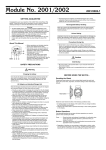
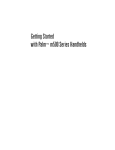

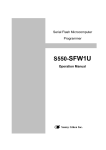

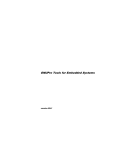
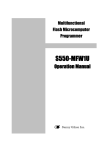
![[S3062PT-CPE-2] User`s Manual(First Edition): CPE62PSUE_2](http://vs1.manualzilla.com/store/data/005668190_1-0d028d6af383e5d06430420ca44dee4c-150x150.png)
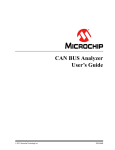
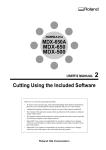
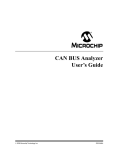
![[S3062PT-CPE] User`s Manual(Third Edition): CPE62PUE](http://vs1.manualzilla.com/store/data/005693507_1-69a1045bbc5cf41449359b406d2a53f2-150x150.png)
